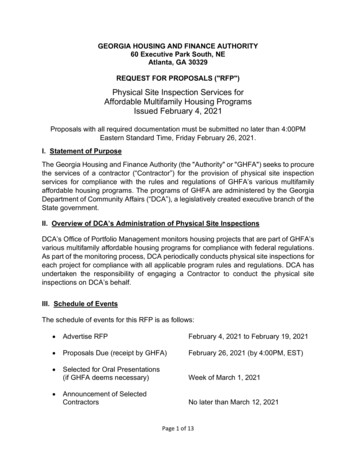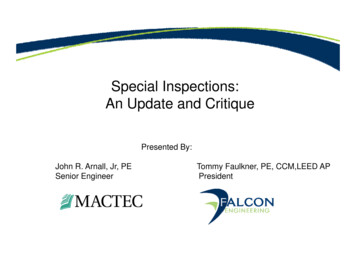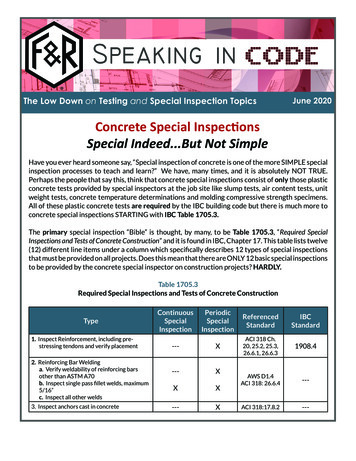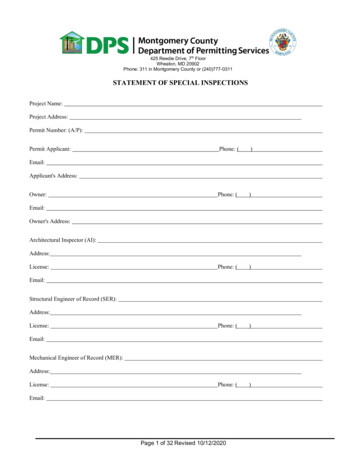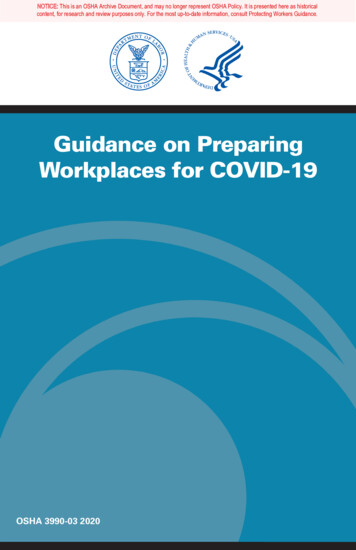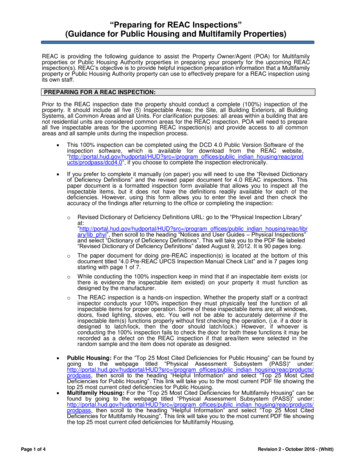
Transcription
“Preparing for REAC Inspections”(Guidance for Public Housing and Multifamily Properties)REAC is providing the following guidance to assist the Property Owner/Agent (POA) for Multifamilyproperties or Public Housing Authority properties in preparing your property for the upcoming REACinspection(s). REAC’s objective is to provide helpful inspection preparation information that a Multifamilyproperty or Public Housing Authority property can use to effectively prepare for a REAC inspection usingits own staff.PREPARING FOR A REAC INSPECTION:Prior to the REAC inspection date the property should conduct a complete (100%) inspection of theproperty. It should include all five (5) Inspectable Areas; the Site, all Building Exteriors, all BuildingSystems, all Common Areas and all Units. For clarification purposes: all areas within a building that arenot residential units are considered common areas for the REAC inspection. POA will need to prepareall five inspectable areas for the upcoming REAC inspection(s) and provide access to all commonareas and all sample units during the inspection process. This 100% inspection can be completed using the DCD 4.0 Public Version Software of theinspection software, which is available for download from the REAC website,“http://portal.hud.gov/hudportal/HUD?src /program offices/public indian housing/reac/products/prodpass/dcd4.0“, if you choose to complete the inspection electronically. If you prefer to complete it manually (on paper) you will need to use the “Revised Dictionaryof Deficiency Definitions” and the revised paper document for 4.0 REAC inspections. Thispaper document is a formatted inspection form available that allows you to inspect all theinspectable items, but it does not have the definitions readily available for each of thedeficiencies. However, using this form allows you to enter the level and then check theaccuracy of the findings after returning to the office or completing the inspection: Page 1 of 4oRevised Dictionary of Deficiency Definitions URL: go to the “Physical Inspection D?src /program offices/public indian housing/reac/library/lib phyi”, then scroll to the heading “Notices and User Guides – Physical Inspections”and select “Dictionary of Deficiency Definitions”. This will take you to the PDF file labeled“Revised Dictionary of Deficiency Definitions” dated August 9, 2012. It is 90 pages long.oThe paper document for doing pre-REAC inspection(s) is located at the bottom of thisdocument titled “4.0 Pre-REAC UPCS Inspection Manual Check List” and is 7 pages longstarting with page 1 of 7.oWhile conducting the 100% inspection keep in mind that if an inspectable item exists (orthere is evidence the inspectable item existed) on your property it must function asdesigned by the manufacturer.oThe REAC inspection is a hands-on inspection. Whether the property staff or a contractinspector conducts your 100% inspection they must physically test the function of allinspectable items for proper operation. Some of these inspectable items are; all windows,doors, fixed lighting, stoves, etc. You will not be able to accurately determine if theinspectable item(s) functions properly without first checking the operation, (i.e. if a door isdesigned to latch/lock, then the door should latch/lock.) However, if whoever isconducting the 100% inspection fails to check the door for both these functions it may berecorded as a defect on the REAC inspection if that area/item were selected in therandom sample and the item does not operate as designed.Public Housing: For the “Top 25 Most Cited Deficiencies for Public Housing” can be found bygoing to the webpage titled “Physical Assessment Subsystem (PASS)“ under:http://portal.hud.gov/hudportal/HUD?src /program offices/public indian housing/reac/products/prodpass, then scroll to the heading “Helpful Information” and select “Top 25 Most CitedDeficiencies for Public Housing”. This link will take you to the most current PDF file showing thetop 25 most current cited deficiencies for Public Housing.Multifamily Housing: For the “Top 25 Most Cited Deficiencies for Multifamily Housing” can befound by going to the webpage titled “Physical Assessment Subsystem (PASS)“ under:http://portal.hud.gov/hudportal/HUD?src /program offices/public indian housing/reac/products/prodpass, then scroll to the heading “Helpful Information” and select “Top 25 Most CitedDeficiencies for Multifamily Housing”. This link will take you to the most current PDF file showingthe top 25 most current cited deficiencies for Multifamily Housing.Revision 2 - October 2016 - (Whitt)
“Preparing for REAC Inspections”(Guidance for Public Housing and Multifamily Properties) Multifamily Housing: For the “Top 25 Most Cited Deficiencies for Multifamily Housing” can befound by going to the webpage titled “Physical Assessment Subsystem (PASS)“ under:http://portal.hud.gov/hudportal/HUD?src /program offices/public indian housing/reac/products/prodpass, then scroll to the heading “Helpful Information” and select “Top 25 Most CitedDeficiencies for Multifamily Housing”. This link will take you to the most current PDF file showingthe top 25 most current cited deficiencies for Multifamily Housing. In addition to the “Top 25 Deficiencies”, special attention should be directed at any possible“Exigent (Life Threatening) Health & Safety” deficiency that may be found. They are:- Propane, natural, or methane gas leaks- Exposed wires or open electrical panels- Water leaks on or near electrical equipment- Blocked or unusable emergency or fire exits- Blocked fire escapes or ladders- Missing or misaligned chimney for gas-fired water heater or HVAC unit- Window security bars preventing exit- Expired fire extinguishers- Inoperative or missing smoke detectors Property staff should adhere to the following when preparing for the REAC inspection:Electrical:oAll electrical boxes, electrical panel boxes, fuse boxes, disconnect boxes, timer boxes,etc., are subject to inspection by the REAC inspector regardless of the location. Theseboxes will be inspected even if behind locked doors (mechanical rooms, electric closets,etc.) for any electrical deficiency that exists.oAll electrical panels and fuse boxes must be made available for inspection whetherlocated inside or outside and secured or unsecured.oAll other electrical boxes, disconnects, timers, etc. will not be opened by the REACinspector if secured at the time of the inspection. A box is considered secured by REACdefinition if it cannot be opened using only your hands. (Using a tool to open isconsidered locked/secured.)oFor additional clarification on electrical defects, reference “Electrical Devices”. It can befound by going to the webpage titled “Physical Inspection Sub-System QualityAssurance (PASS-QA)” under:http://portal.hud.gov/hudportal/HUD?src /program offices/public indian housing/reac/products/pass/qa , then scroll to the heading “Guidelines for Inspections” and select“Electrical Devices”. This link will take you to the most current PDF file showing how tohandle the common electrical defects.Blocked Egress:oPage 2 of 4All individual living areas/rooms in a unit and all common area rooms must have 2independent and unimpeded means of egress (escape) if so designed. The only exceptionis windows above the 3rd floor that do not serve as a means of access to a designedescape route. (Additional clarification to “Blocked Egress” can be found in the REACPASS Compilation Bulletin on page 36 at:http://portal.hud.gov/hudportal/HUD?src /program offices/public indian housing/reac/products/pass/pass bulletin, then under “RAPID 4.0” select the most recent version of theCompilation Bulletin.) In cases where local code differs with this standard, either a letterfrom a local code official or a copy of the code should be provided/submitted within theguidelines of the TR/DBA process so that applicable lost points can be restored.Revision 2 - October 2016 - (Whitt)
“Preparing for REAC Inspections”(Guidance for Public Housing and Multifamily Properties)Industry Standard Repairs:oStates that Sub-Standard industry repairs on all HUD REAC properties will NO longer beacceptable.oAll repairs should be consistent with what a reasonable person would expect if a repairwas done to an Apartment they lived in or what they would expect to see when shoppingfor a New Apartment.oAll repairs shall be made in a professional manner with similar materials, free from defects& consistent with existing condition and not stand out as an obvious repair wheneverpossible.oFor additional clarification on industry standard repairs, reference “Industry StandardRepairs”. It can be found by going to the webpage titled “Physical Inspection Sub-SystemQuality Assurance (PASS-QA)” under:http://portal.hud.gov/hudportal/HUD?src /program offices/public indian housing/reac/products/pass/qa , then scroll to the heading “Guidelines for Inspections” and select “IndustryStandard Repairs”. This link will take you to the most current PDF file showing how tohandle repairs.ON THE DAY OF THE INSPECTION HAVE THE FOLLOWING INFORMATION AVAILABLE FORTHE INSPECTOR: Certificates (If applicable) for: Boilers, Fire Alarm, Building Sprinkler System, Elevator andLead Based Paint Report and Resident Disclosure form(s) if the property has a buildingbuilt prior to 1978. Area Measures: Parking Lots / Driveways / Roads (square footage) and Walkways / Steps(square footage). Rent Roll: Should be current for the day of the inspection and must contain all occupiedunits, vacant units, non-revenue units (occupied by Site Manager, other property staff, etc.),and bedroom sizes of all units. If the purpose of any of these dwelling units changes to anon-dwelling use you will need to inform the inspector and it must be removed from the unitcount. (i.e. – Unit converted to an Office, Storage, Police Substation, Daycare, etc.) Site Map (If available): This enables the inspector to navigate the property with the escort ina more efficient manner.IMPORTANT POINTS TO REMEMBER: When the inspector contacts the property POA to schedule the inspection it must be amutually agreeable time/date. The inspection should take place only during normal business hours. You should not schedule the maintenance/service of any of the inspectable items the day ofthe inspection, (i.e. elevators – “Out of Order” due to planned maintenance will be cited fora Level 3 deficiency). If property staff or contractors have work in progress or have recently completed work thatrequired the removal of panel covers exposing electrical wiring/connections, outlet/switchplate covers, etc. you will need to ensure that these items have been properly re-installed.o Page 3 of 4Note: “Work in Progress” - If buildings or units are occupied and rehabilitation work is inprogress during the inspection, the inspector must inspect the buildings or units. Alldeficiencies most be recorded, even defects associated with ongoing work in progressduring the REAC inspection.Carry a notepad and camera with you during the REAC inspection to document the variousfindings when appropriate.Revision 2 - October 2016 - (Whitt)
“Preparing for REAC Inspections”(Guidance for Public Housing and Multifamily Properties) The property staff is required to provide the inspector with access to all inspectable areasand all inspectable items within the sample units and sample building common areas. If the POA cannot, or will not, provide the inspector access to an inspectable items, theinspector must record that item as defective. You are allowed to do the following during the inspection:oIn a unit or common area the POA may install a light bulb to demonstrate that apermanent light fixture functions properly. If the permanent light fixture functionsproperly after installing a light bulb, it is not a defect.oIf a pilot light is out for one or more gas burners, the POA may light the pilot and test theburners. If all burners function after lighting the gas pilot light, a Level 1 deficiency isrecorded in lieu of a Level 2 or Level 3.oElectric Stove – if burners have been removed for cleaning, the POA will be allowed toplug burners back in to show all work properly (no repairs are allowed). If all burnersfunction properly, no defect will be recorded.oGas/Electric Stoves – if knobs are missing, the POA will be allowed to find and installknobs to show all burners/oven work properly. No defect will be recorded if all knobsare found and all burners/oven work properly. Missing knob(s) will be a Level 1 defect ifall burners/oven work properly.oIf the exhaust fan in the bathroom has been unplugged, the POA may plug the exhaustfan in and if it functions properly there is no deficiency recorded.SUPPLEMENTAL GUIDANCE:The “REAC Compilation Bulletin” and “REAC Inspector Notices” are clarifications of the definitions andtake priority over the written definitions in the inspection 4.0 software. The “Inspector Business Rules”detail the protocol for conducting the REAC inspection. The POA will need to familiarize their self withthese documents:REAC Compilation Bulletin URL:http://portal.hud.gov/hudportal/HUD?src /program offices/public indian housing/reac/products/pass/pass bulletin, then under “RAPID 4.0” select the most recent version of the Compilation Bulletin.Inspector Notices URL:http://portal.hud.gov/hudportal/HUD?src /program offices/public indian housing/reac/products/pass/qa,then scroll to the heading “Guidelines for Inspections” and select the appropriate title for one of severalnew Inspector Notices. Also, for older Inspector Notices, look under the heading “Physical InspectionProtocol” and select “Inspector Notices & User Guides”.Inspector Business Rules URL:http://portal.hud.gov/hudportal/HUD?src /program offices/public indian housing/reac/products/pass/qa,then scroll to the heading “Physical Inspection Protocol” and select “Inspector Notices & User Guides”.Then select “Inspect Notice 2002-02 Business Rules Inspector Performance Monitoring”.Page 4 of 4Revision 2 - October 2016 - (Whitt)
4.0 Pre-REAC UPCS Inspection Manual Check List4.0 Uniform Physical Condition Standards - Comprehensive ListingInspectable Area: SitePage: ofProperty ID / Name:Close to Building Number / Name:Inspectable ItemObservable DeficiencyFencing and GatesNon-Security or Non-Safety Fencing and GatesSecurity or Safety Fencing and GatesErosion/Rutting AreasOvergrown/Penetrating VegetationPonding/Site DrainageGroundsMailboxes/Project SignsMailbox Missing/DamagedSigns DamagedMarket AppealGraffitiLitterParking Lots/Driveways/RoadsDamaged PavingNODInspection Date:1Level23NAH&SNLTNLTNLTCracksPotholes/Loose MaterialSettlement/HeavingPondingNLTRefuse DisposalDamaged/Broken EquipmentDeteriorated Play Area SurfaceBroken/Damaged Enclosure - Inadequate Outside Storage SpaceRetaining WallsDamaged/Falling/LeaningNLTStorm DrainageDamaged/ObstructedPlay Areas and EquipmentWalkways/StepsHealth and SafetyCracks/Settlement/HeavingBroken/Missing Hand RailingSpallingAir Quality - Mold or MildewAir Quality - Sewer Odor DetectedAir Quality - Propane/Natural Gas/Methane Gas DetectedElectrical Hazards - Exposed Wires/Opening in PanelsElectrical Hazards - Water Leaks on/near Electrical EquipmentFlammable Materials - Improperly StoredGarbage and Debris - OutdoorsHazards - Sharp EdgesHazards - TrippingHazards - OtherInfestation - InsectsInfestation - LT- In order to accurately categorize a deficiency as a "Level 1", "Level 2" or "Level 3" (including independent Health & Safetyitems); you must refer to the PDF file labeled “Revised Dictionary of Deficiency Definitions” Version 4.0, dated 08/09/2012 (90Pages). This document can be found at:“http://portal.hud.gov/hudportal/HUD?src /program offices/public indian housing/reac/library/lib phyi”, then scroll to the heading “Noticesand User Guides – Physical Inspections” and select “Dictionary of Deficiency Definitions”- Additional clarification to these definitions is contained in the REAC PASS Compilation Bulletin which can be found at“http://portal.hud.gov/hudportal/HUD?src /program offices/public indian housing/reac/products/pass/pass bulletin”, then under “RAPID4.0” select the most recent version of the Compilation Bulletin- Only level 3 is applied to independent Health & Safety deficiencies.- In the H&S column, NLT is a "Non-Life Threatening" Health & Safety concern whereas LT is a "Life Threatening" concern which calls forimmediate attention or remedy and will show up on the Exigent Health and Safety Report at the end of an inspection.Page 1 of 7Revision 2 - October 2016 - (Whitt)
4.0 Pre-REAC UPCS Inspection Manual Check List4.0 Uniform Physical Condition Standards - Comprehensive ListingInspectable Area: Building ExteriorPage: ofProperty ID / Name:Building Number/Name:Inspectable ItemDoorsObservable DeficiencyDamaged Frames/Threshold/Lintels/TrimDamaged Hardware/LocksDamaged Surface (Holes/Paint/Rusting/Glass)Damaged/Missing Screen/Storm/Security DoorDeteriorated/Missing Caulking/SealsMissing DoorFire EscapesBlocked Egress/LaddersVisibly Missing ComponentsFoundationsCracks/GapsSpalling/Exposed RebarLightingBroken Fixtures/BulbsRoofsWallsWindowsHealth and SafetyNODInspection Date:1Level23NAH&SNLTNLTLTLTDamaged Soffits/FasciaDamaged VentsDamaged/Clogged DrainsDamaged/Torn Membrane/Missing BallastMissing/Damaged Components from Downspout/GutterMissing/Damaged ShinglesPondingCracks/GapsDamaged ChimneysMissing/Damaged Caulking/MortarMissing Pieces/Holes/Spalling/RottenStained/Peeling/Needs PaintBroken/Missing/Cracked PanesDamaged Sills/Frames/Lintels/TrimDamaged/Missing ScreensMissing/Deteriorated Caulking/Seals/Glazing CompoundPeeling/Needs PaintSecurity Bars Prevent EgressAir Quality - Mold or MildewAir Quality - Propane/Natural Gas/Methane Gas DetectedElectrical Hazards - Exposed Wires/Open PanelsElectrical Hazards - Water Leaks on/near Electrical EquipmentEmergency Fire Exits - Emergency/Fire Exits Blocked/UnusableEmergency Fire Exits - Missing Exit SignsFlammable/Combustible Materials - Improperly StoredHazards - Sharp EdgesHazards - TrippingHazards - OtherInfestation - InsectsInfestation - NLTNLT- In order to accurately categorize a deficiency as a "Level 1", "Level 2" or "Level 3" (including independent Health & Safety items); you mustrefer to the PDF file labeled “Revised Dictionary of Deficiency Definitions” Version 4.0, dated 08/09/2012 (90 Pages). This d ocument can befound at: “http://portal.hud.gov/hudportal/HUD?src /program offices/public indian housing/reac/library/lib phyi”, then scroll to the heading “Notices and UserGuides – Physical Inspections” and select “Dictionary of Deficiency Definitions”- Additional clarification to these definitions is contained in the REAC PASS Compilation Bulletin which can be found at“http://portal.hud.gov/hudportal/HUD?src /program offices/public indian housing/reac/products/pass/pass bulletin”, then under “RAPID 4.0” select themost recent version of the Compilation Bulletin- Only level 3 is applied to independent Health & Safety deficiencies.- In the H&S column, NLT is a "Non-Life Threatening" Health & Safety concern whereas LT is a "Life Threatening" concern which calls for immediate attention orremedy and will show up on the Exigent Health and Safety Report at the end of an inspection.Page 2 of 7Revision 2 - October 2016 - (Whitt)
4.0 Pre-REAC UPCS Inspection Manual Check List4.0 Uniform Physical Condition Standards - Comprehensive ListingInspectable Area: Building SystemsPage: ofProperty ID / Name:Building Number/Name:Inspectable ItemDomestic WaterObservable DeficiencyLeaking Central Water SupplyMisaligned Chimney/Ventilation SystemMissing Pressure Relief ValveRust/Corrosion on Heater ChimneyWater Supply InoperableNODInspection Date:1LEVEL23NAH&SLTNLTNLTNLTBlocked Access/Improper StorageBurnt BreakersEvidence of Leaks/CorrosionFrayed WiringMissing Breakers/FusesMissing CoversNLTNLTNLTElevatorsNot OperableNLTEmergency PowerAuxiliary Lighting InoperableRun-Up Records/Documentation Not AvailableFire ProtectionMissing Sprinkler HeadMissing/Damaged/Expired ExtinguishersNLTLTBoiler/Pump LeaksFuel Supply LeaksGeneral Rust/CorrosionMisaligned Chimney/Ventilation SystemNLTNLTLTElectrical SystemHVACRoof Exhaust SystemSanitary SystemRoof Exhaust Fan(s) InoperableBroken/Leaking/Clogged Pipes or DrainsNLTMissing Drain/Cleanout/Manhole CoversAir Quality - Mold and/or Mildew ObservedAir Quality - Propane/Natural Gas/Methane Gas DetectedAir Quality - Sewer Odor DetectedElectrical Hazards - Exposed Wires/Open PanelsElectrical Hazards - Water Leaks on/near Electrical EquipmentElevator - TrippingHealth & SafetyLTLTEmergency Fire Exits - Emergency/Fire Exits Blocked/UnusableNLTLTNLTLTLTNLTLTEmergency Fire Exits - Missing Exit SignsNLTFlammable Materials - Improperly StoredNLTGarbage and Debris - IndoorsNLTHazards - OtherNLTHazards - Sharp EdgesNLTHazards - TrippingNLTInfestation - InsectsInfestation - Rats/Mice/VerminNLTNLT- In order to accurately categorize a deficiency as a "Level 1", "Level 2" or "Level 3" (including independent Health & Safety items); youmust refer to the PDF file labeled “Revised Dictionary of Deficiency Definitions” Version 4.0, dated 08/09/2012 (90 Pages). T his documentcan be found at: “http://portal.hud.gov/hudportal/HUD?src /program offices/public indian housing/reac/library/lib phyi”, then scroll to the heading“Notices and User Guides – Physical Inspections” and select “Dictionary of Deficiency Definitions”- Additional clarification to these definitions is contained in the REAC PASS Compilation Bulletin which can be found at“http://portal.hud.gov/hudportal/HUD?src /program offices/public indian housing/reac/products/pass/pass bulletin”, then under “RAPID 4.0”select the most recent version of the Compilation Bulletin- Only level 3 is applied to independent Health & Safety deficiencies.- In the H&S column, NLT is a "Non-Life Threatening" Health & Safety concern whereas LT is a "Life Threatening" concern which calls for immediateattention or remedy and will show up on the Exigent Health and Safety Report at the end of an inspection.Page 3 of 7Revision 2 - October 2016 - (Whitt)
4.0 Pre-REAC UPCS Inspection Manual Check List4.0 Uniform Physical Condition Standards - Comprehensive ListingInspectable Area: Common AreasProperty ID / Name:Building Number/Name:X Inspectable Item anicalCommunity RoomDay CareHalls/Corridors/StairsKitchenLaundry RoomLobbyOfficeOther Community SpacesPatio/Porch/BalconyRestrooms/Pool StructuresStorageObservable DeficiencyBaluster/Side Railings - DamagedDamaged/MissingPlumbing - Clogged DrainsPlumbing - Leaking Faucet/PipesRestroom Cabinet - TubPlumbing - Clogged DrainsPlumbing - Leaking Faucet/PipesVentilation/Exhaust System - InoperableWater Closet/Toilet - Damaged/Clogged/MissingCall for Aid - InoperableBulging/BucklingHoles/Missing Tiles/Panels/CracksCeilingPeeling/Needs PaintWater Stains/Water Damage/Mold/MildewDamaged Frames/Threshold/Lintels/TrimDamaged Hardware/LocksDamaged Surface (Holes/Paint/Rust/Glass)DoorsDamaged/Missing Screen/Storm/Security DoorDeteriorated/Missing Seals (Entry Only)Missing DoorDryer Vent -Missing/Damaged/InoperableBlocked Access to Electrical PanelBurnt BreakersEvidence of Leaks/Corrosion/Rust/Stains affect currentElectricalFrayed WiringMissing BreakersMissing CoversBulging/BucklingHard Floor CoveringCarpetFloorsPeeling/Needs PaintRot/Deteriorated SubfloorWater Stains/Water Damage/Mold/MildewGFI - InoperableGraffitiConvection/Radiant Heat System CoversMissing/DamagedGeneral Rust/CorrosionHVACInoperableMisaligned Chimney/Ventilation SystemNoisy/Vibrating/LeakingLavatory SinkPage: ofInspection Date:NOD1Level23NA T(Common Areas Continued on Next Page)Page 4 of 7Revision 2 - October 2016 - (Whitt)
(Common Areas Continued from Previous Page)4.0 Pre-REAC UPCS Inspection Manual Check ListX Inspectable Item anicalCommunity RoomDay CareHalls/Corridors/StairsKitchenObservable DeficiencyCabinets - Missing/DamagedCountertops - Missing/DamagedDishwasher/Garbage DisposalMissing/DamagedKitchenSinkPlumbing - Clogged DrainsItemsPlumbing - Leaking Faucet/PipesRange Hood /Exhaust Fans - ExcessiveLaundry RoomGrease/InoperableLobbyRange/Stove - Missing/Damaged/InoperableOfficeRefrigerator - Damaged/InoperableOther Community SpacesLighting - Missing/Damaged/Inoperable FixturePatio/Porch/BalconyMailbox - Missing/DamagedRestrooms/Pool StructuresOutlets/Switches/Cover Plates - Missing/BrokenStoragePedestrian/Wheelchair RampSmoke Detector - Missing/InoperableStairs - Broken/Damaged/Missing StepsStairsStairs - Broken/Missing Hand RailingBulging/BucklingDamaged – ed TrimPeeling/Needs PaintWater Stains/Water Damage/Mold/MildewCracked/Broken/Missing PanesDamaged Window SillInoperable/Not LockableMissing/Deteriorated Caulking/Seals/GlazingWindowsCompoundPeeling/Needs PaintScreensSecurity Bars Prevent EgressFencing - Damaged/Not IntactPools and Related StructuresPool - Not OperationalChutes - Damaged/Missing ComponentsTrash Collection AreasAir Quality - Mold and/or Mildew ObservedAir Quality - Propane/Natural Gas/Methane Gas DetectedAir Quality - Sewer Odor DetectedElectrical Hazards - Exposed Wires/Open PanelsElectrical Hazards - Water Leaks on/near Electrical EquipmentEmergency Fire Exits - Emergency/Fire Exits Blocked/UnusableHealth & SafetyEmergency Fire Exits - Missing Exit SignsFlammable/Combustible Materials - Improperly StoredGarbage and Debris - IndoorsGarbage and Debris - OutdoorsHazards - OtherHazards - Sharp EdgesHazards - TrippingInfestation - InsectsInfestation - Rats/Mice/VerminNOD1Level23NA NLTNLTNLTNLTNLTNLTNLT- In order to accurately categorize a deficiency as a "Level 1", "Level 2" or "Level 3" (including independent Health & Safety items); you must refer to the PDF file labeled “RevisedDictionary of Deficiency Definitions” Version 4.0, dated 08/09/2012 (90 Pages). This document can be found at:“http://portal.hud.gov/hudportal/HUD?src /program offices/public indian housing/reac/library/lib phyi”, then scroll to the heading “Notices and User Guides – Physical Inspections” and select “Dictionary ofDeficiency Definitions”- Additional clarification to these definitions is contained in the REAC PASS Compilation Bulletin which can be found at“http://portal.hud.gov/hudportal/HUD?src /program offices/public indian housing/reac/products/pass/pass bulletin”, then under “RAPID 4.0” select the most recent version of the Compilation Bulletin- Only level 3 is applied to independent Health & Safety deficiencies.- In the H&S column, NLT is a "Non-Life Threatening" Health & Safety concern whereas LT is a "Life Threatening" concern which calls for immediate attention or remedy and will show up on the Exigent Health andSafety Report at the end of an inspection.Page 5 of 7Revision 2 - October 2016 - (Whitt)
4.0 Pre-REAC UPCS Inspection Manual Check List4.0 Uniform Physical Condition Standards - Comprehensive ListingInspectable Area: UnitsPage: ofProperty ID / Name:Building/Unit NumberInspection Date:LevelInspectable ItemBathroomCall-for-AidObservable DeficiencyBaluster/Side Railings - DamagedBathroom Cabinets - Damaged/MissingLavatory Sink - Damaged/MissingPlumbing - Clogged DrainsPlumbing - Leaking Faucet/PipesShower/Tub - Damaged/MissingVentilation/Exhaust System - InoperableWater Closet/Toilet - LTCeilingInoperableBulging/BucklingHoles/Missing Tiles/Panels/CracksPeeling/Needs PaintWater Stains/Water Damage/Mold/MildewNLTDoorsDamaged Frames/Threshold/Lintels/TrimDamaged Hardware/LocksDamaged/Missing Screen/Storm/Security DoorDamaged Surface - Holes/Paint/Rusting/GlassDeteriorated/Missing Seals (Entry Only)Missing DoorBlocked Access to Electrical PanelBurnt BreakersEvidence of Leaks/CorrosionFrayed WiringGFI - InoperableMissing Breakers/FusesMissing CoversNLTNLTNLTElectrical SystemFloorsHot Water HeaterHVAC SystemNLTNLTNLTLTLTBulging/BucklingHard Floor CoveringCarpetPeeling/Needs PaintRot/Deteriorated SubfloorWater Stains/Water Damage/Mold/MildewMisaligned Chimney/Ventilation SystemInoperable Unit/ComponentsLeaking Valves/Tanks/PipesPressure Relief Valve MissingRust/CorrosionConvection/Radiant Heat System Covers Missing/DamagedGeneral Rust/CorrosionInoperableMisaligned Chimney/Ventilation SystemNoisy/Vibrating/LeakingLTNLTNLTNLTLT(Unit Continued on Next Page)Page 6 of 7Revision 2 - October 2016 - (Whitt)
(Unit Continued from Previous Page)4.0 Pre-REAC UPCS Inspection Manual Check ListInspectable ItemKitchenObservable DeficiencyCabinets - Missing/DamagedCountertops - Missing/DamagedDishwasher/Garbage Disposal - InoperablePlumbing - Clogged DrainsPlumbing - Leaking Faucet/PipesRange Hood/Exhaust Fans - Excessive Grease/InoperableRange/Stove - aged/InoperableSink - Damaged/MissingLaundry Area (Room)Dryer Vent - Missing/Inoperable FixtureMissingMissing/Broken Cover PlatesPatio/Porch/BalconyBaluster/Side Railings DamagedSmoke DetectorMissing/InoperableBroken/Damaged/Missing StepsBroken/Missing Hand RailingBulging/BucklingDamagedDamaged/Deteriorated TrimPeeling/Needs PaintWater Stains/Water Damage/Mold/MildewCracked/Broken/Missing PanesDamaged Window SillMissing/Deteriorated Caulking/Seals/Glazing CompoundInoperable/Not LockablePeeling/Needs PaintScreensSecurity Bars Prevent EgressStairsWallsWindowsHealth & SafetyAir Quality - Mold and/or Mildew ObservedAir Quality - Sewer Odor DetectedAir Quality - Propane/Natural Gas/Methane
permanent light fixture functions properly. If the permanent light fixture functions properly after installing a light bulb, it is not a defect. o If a pilot light is out for one or more gas burners, the POA may light the pilot and test the burners. If all burners function after lighting the
